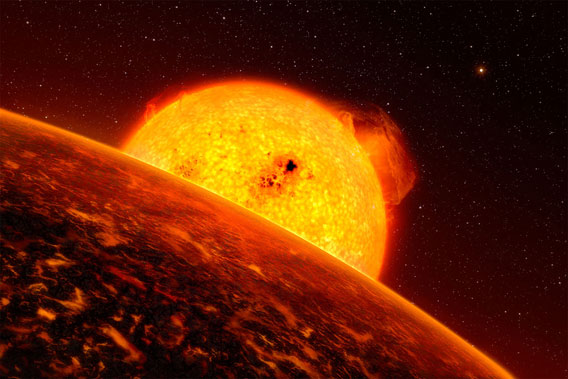Create a free profile to get unlimited access to exclusive videos, sweepstakes, and more!
A Boiling Lava Planet With an Eight-Hour Year

Another really weird planet orbiting another star has been found, and itâs a world of extremes: The orbital periodâits yearâis only 8½ hours long, and itâs so hot it must have a molten surface of boiling lava. Not only that, but itâs roughly the same size as Earth!
The planet is called Kepler-78b and is located about 700 light-years from Earth. The parent star, called just Kepler-78, is slightly smaller, cooler, and lower mass than the Sun. Itâs less than 1 billion years old, making it far younger than the Sun as well.
The planet was detected using the transit method. If a planetâs orbit is edge-on as seen from Earth, it blocks a tiny bit of light from the star every time it orbits (like a bug flying between you and a light). The star is relatively brightâabout 11th magnitude, visible in a small telescopeâwhich means it was extremely well-observed, and even though the amount of light blocked by the planet was tiny, it boomed right out of the observations:
That diagram is from the announcement paper for the planet. When I saw it, I was stunned. Itâll take a moment to explain why, but bear with me. This is cool.
First, the graph plots light from the star and planet over time; about 12 hours is covered. The big dip is from when the planet is directly between us and the star. The units on the left are parts per million, so the planet blocks about 200 one-millionths of the starâs light, or 0.02 percent. Thatâs a teeny tiny amount, but clearly seen.
The black dots plot the starlight over one planetary orbit, and it repeats at about the seven-hour mark. (Itâs plotted this way to make it easy to see the repeating pattern in the light.) The diagram inset in the middle shows the relative size of the star, planet, and the planetâs orbit (dashed line). Thatâs to scale: The planet circles the star, staying just three times the starâs own radius from the surface! That means the planet is boiling hot, with a surface temperature of about 4,800 degrees Celsius (8,700 degrees Fahrenheit).
But itâs the middle part of the graph that blew me away. If the light we saw were steady, then that would be a flat line between transits. But itâs not: You can see it rises a bit, then there is a second, much shallower dip starting at the 3½-hour mark, then it drops slowly again.
What youâre seeing there is the light from the planet itself, changing like the phases of the Moon as it orbits the star, and then getting blocked as it passes behind the star.
Thatâs astonishing. I mean, seriously, weâre seeing the changing phase of the planet itself! Hereâs an animation made for a similar discovery in 2009, showing how this works:
When the planet is directly between the star and us, we see its unlit half. As it orbits around the star, we see gradually more of it, lit like a crescent Moon, so it gets brighter. Then we see it half full, three-quarters full ⦠and just as weâd see it becoming fully lit, it passes behind the star itself, and we get that little dip in the light. So what youâre seeing there is actually the combined light of the star and the planet, too. Weâre probably seeing reflected starlight off the planet, like the Moon is lit from the Sun. But again, note the small change: It only adds up to about 10 parts per million! The star is hundreds of thousands of times brighter, but the planet makes itself get noticed in all that blaring light.
Kepler-78b is a pretty spectacular place. While we canât determine its mass very well, itâs certainly less than about eight times the Earthâs mass, most likely close to Earthâs own heft. Itâs only about 1.2 times the radius of the Earth, so itâs very close to our size. But Earth it ainât. Poking around the Web, I didnât find any common metals that are solid at 4,800 degrees Celsius, which means no matter what, the surface of this planet is molten. If it has an atmosphere at all, itâll be vaporized rock and metals.
And on top of it all, its year is only a few hours long. Only a handful of planets known orbit their stars more rapidly. That close to the star itâs probably tidally locked, too, so it always shows the same face to the star; one side of the planet is infernally hot and the other would be somewhat cooler. But even so, the whole surface would be a world-spanning ocean of churning liquid rock and metal. Crazy.
This is yet more evidence that the Universe is more clever than we are when it comes to creating worlds. But weâre clever, too, and we can find them. And the more we see, the better we understand how they form, how they exist, and the more we are able to understand about our own blue-greenâand very temperateâplanet.


























